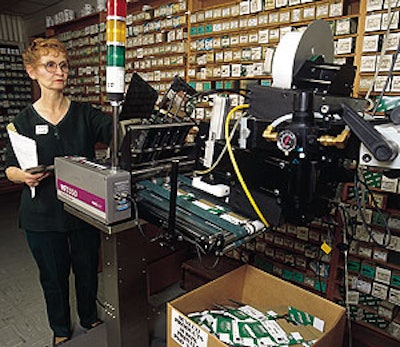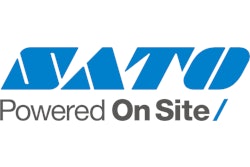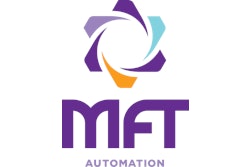With the addition of a print-and-apply labeler, Covington, KY-based Au-ve-co Products can now print product information and bar codes that its previous printing machinery could not. The information is printed onto labels that are then automatically applied to knocked-down folding cartons that will be later erected and filled with the company’s automotive parts.
Added in late ’99, the new equipment from Paragon Labeling Systems (White Bear Lake, MN) helps Au-ve-co meet ever-increasing sales volume, while reducing maintenance and changeover time by 10%.
Au-ve-co, short for Auto-Vehicle Co., produces fasteners and automotive collision repair parts, in weights from 2 oz to 2 lb. The parts are not sold at retail, but rather to body shops and repair centers.
The labeler functions at the company’s 65ꯠ sq’ Covington location, though the company expects to move to a 100ꯠ sq’ facility this summer, says Joseph Hohe, the company’s vice president of operations.
Before adding the Paragon unit, tabletop printers printed labels that were hand-applied to cartons. For some higher-volume products, Au-ve-co relied on imprinters that used rubber plates to directly imprint knocked-down cartons. “The rubber plates did not last very long, and they took time to maintain,” Hohe recalls.
“We had to pull plates off the machine and clean them because we had problems with the inks,” he adds. “On top of that, we do changeovers two or three times a day. Each takes an operator five to 10 minutes to do. We could not keep going the way we were. We could not keep up with growing production requirements. We also could not address requirements to provide good bar codes and the amount of product information we wanted.”
To overcome these limitations, Au-ve-co researched machinery builders. After a Paragon sales representative visited Au-ve-co, Hohe says the rep “worked out the details. And while the equipment didn’t project as the cheapest, it was well-designed and looked like it would best do the job.” The print-and-apply labeler became part of a turnkey solution provided by a Paragon distributor (see sidebar, p. 33).
How it works
The print-and-apply process begins as an operator loads flat carton blanks into a magazine on the Paragon machine. At the time of Packaging World’s interview, Au-ve-co was evaluating carton vendors and preferred not to identify suppliers.
The operator also enters the product/case SKU number, which triggers the host computer to search a database and fill in as many as 15 information areas that will be later printed onto the label. “We download information from the machine’s computer to the thermal-transfer printer,” Hohe notes. The print engine on this unit is from Sato (Sunnyvale, CA). “The computer tells the printer that it needs to print a particular image in a specific format, and print a certain number of them.”
The Paragon machine is equipped with an MTF350 friction feeder from Multifeeder Technology (St. Paul, MN). The feeder’s drivewheel and conveying belts deliver carton blanks one at a time from a magazine. Cartons index along the sidebelt conveyor.
A fiber-optic sensor detects the leading edge of the carton blank, triggering the unit to print the appropriate information onto the label. The printed label is separated from the rollstock onto a labeling head that holds it by vacuum. The vacuum is released before the labeler’s air cylinder drives the label to the carton blank and tamps down the label.
Labeled cartons discharge into a bin. At six manual packing stations, blanks are erected and filled, typically to accommodate parts quantities of 25, 50, or 100. Au-ve-co also uses some automated packaging equipment. Hohe says the plant runs 10 hours a day, five days a week, 52 weeks per year. Cartons are packed into cases for shipment to automotive repair shops nationwide.
‘Piggy-back’ labels
Au-ve-co uses four carton sizes, but only two label sizes: 1½” H x 4¼” W or 1” H x 37/8” W. Printed in black only, the two-ply pressure-sensitive label rollstock is supplied by Concorde Labeling Systems (Cincinnati, OH).
According to Concorde, the label structure includes a 43# paper carrier web/pressure-sensitive acrylic adhesive/43# paper liner/p-s acrylic adhesive/50# paper face sheet. Essentially, it’s two labels in one, described by both Concorde and Au-ve-co as a “piggy-back” label. Au-ve-co considers this label critical.
“With the piggy-back labels, our customers can remove the label from our box and put the label on a metal bin where they store our products,” Hohe notes. Concorde die-cuts through the top face sheet so that auto body shop personnel can easily remove the top label, either in its entirety or just the part that shows the bar code.
“That way they can identify the parts,” says Hohe. “While these aren’t consumer products, there is a need for graphics because some of these parts are difficult to describe without a picture.
“We have 15 different data fields in the database where we can add size, application details, OEM numbers, general descriptions, graphics, part numbers, quantity, bar code, and the date the box was labeled,” he adds with satisfaction.
Hohe explains, “The bar codes benefit customers because they can use them for inventory purposes, and they benefit us for picking purposes. We have an inventory software system that we use with our customers so that when they get low on a part, they can scan the part from the label on the bin and order from us electronically.”
Needs little attention
The Paragon unit produces labels for about 12ꯠ cartons a day, running at speeds to 60/min. It’s become an essential tool for Au-ve-co. And its small 5’L x 4’W footprint takes up little space. It’s also easy to maintain, Hohe says, adding that “it doesn’t need much attention.”
When asked about machine payback, Hohe says, “return on investment wasn’t the main justification. We needed the equipment to do things we couldn’t do before. The ability to print bar codes, date-code the cartons and do the piggy-back labels are the key advantages for us. And our customers seem to love the labels.”


























